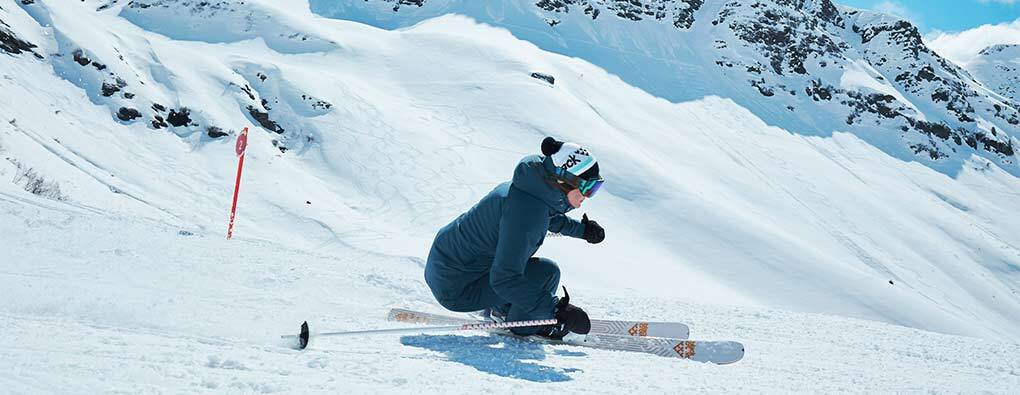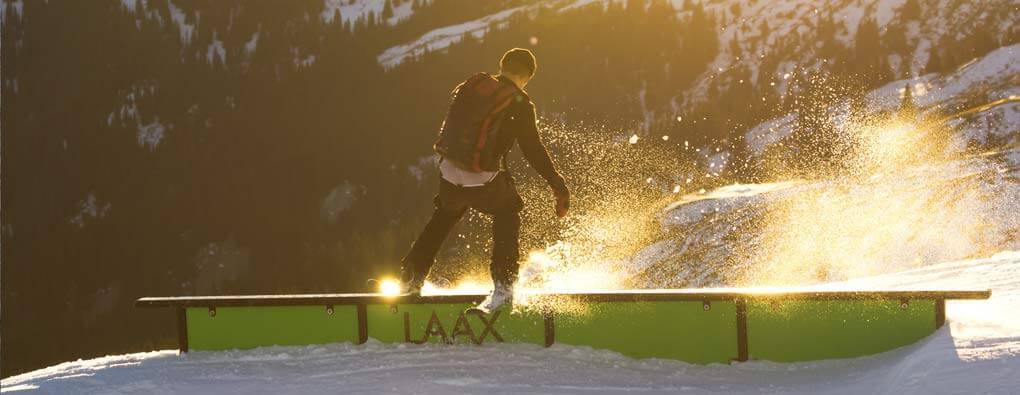Purchasing Skis for Intermediate Skiers
For those who have been skiing for some time and are looking to acquire skis that match their abilities, this guide can provide insight. Being more experienced than a beginner, and skiing with assurance, requires skis that offer increased responsiveness for continued progress.
With numerous options available for advanced skiers, directing one's focus on preferred skiing locations can help in selecting skis suited for specific terrains and techniques.
Factors such as width, turning radius, and unique ski profiles will assist in tailoring your choices. This guide aims to help you discover the ideal skis for your skiing preferences, ensuring an unforgettable ski holiday.
For those new to skiing or still beginning, we also offer a guide catered to beginners. Take a look at our Ski Buying Guide for Beginners for more information.
ALL MOUNTAIN SKIS - Ideal all-purpose skis

All Mountain skis are suitable for those who enjoy a combination of on and off-piste adventures. While most effective on groomed runs, they can also manage softer off-piste snow. You can spend the entire day skiing without stressing about varying snow quality on the tracks. Despite their adaptability to different snow conditions, they are not specialized for any single terrain. An additional feature of these skis is the rocker tip, which elevates the front of the ski for smoother turns and stability on uneven surfaces. If having a single pair of versatile skis is your goal, these are a perfect choice.
Selecting All Mountain skis:There are numerous All Mountain skis available, and their performance can vary based on snow conditions. One distinguishing factor is the waist width, ranging from 80 to 100 mm. Skis with a narrow width are best for on-piste, while a wider width enhances off-piste performance. If you primarily ski on-piste but occasionally venture off-piste, selecting skis closer to 80 mm in width is wise. Conversely, for exploring softer snow near the runs, opt for those nearing 100 mm in width. Explore our All Mountain Skis selection
PISTE SKIS - Optimal for carving groomed trails

Piste skis are perfect for those who prefer to ski on groomed paths and refine their technique. With a narrow waist, typically between 68 to 80 mm, and a camber profile, they grip firmly to the snow, allowing for superior control.
Selecting Piste skis:
Skiers predominantly staying on-piste usually develop a turning style that complements specific turn sizes. Choosing skis with a turning radius that aligns with your style maximizes their potential. The turning radius for Piste skis is usually 13 to 17 m, with smaller numbers accommodating tighter turns and larger numbers providing broader turns. It's important to note that Piste Skis vary widely, so be sure to find skis that match your level. Beginner skis are designed to be softer and more forgiving, whereas expert skis are stiffer and heavier.
Piste skis also offer high-end Race skis, known for being very stiff and performance-driven. Slalom Race Skis (SL) have a compact turning radius, approximately 10 to 13 m, whereas Giant Slalom Race Skis (GS) boast a larger turning radius of 22 m or more for enhanced stability.
Discover our Piste skis collectionPARK SKIS/TWIN TIP SKIS - Best for tricks and stunts

Park skis cater to those eager to spend time practicing tricks such as jumps, boxes, and halfpipes in the snowpark. Featuring a twin tip profile, which sees both ends of the skis curve up sharply, skiers gain the advantage of taking off or landing backward without tail interference. Bindings are typically mounted closer to the ski's centre to assist with weight distribution while performing spins and jumps.
Selecting Park skis:When deciding on the right park skis, it's beneficial to consider the tricks you wish to execute. If focusing on having fun with stunts on boxes and rails, consider Park skis with a broader waist, around 85 to 105 mm, for enhanced stability. These skis tend to be soft and flexible. Conversely, for higher speeds and larger jumps, narrower Park skis with a waist width of 80 to 95 mm, known for their stiffness and stability at high speeds or in landings, would be suitable. Check out our Park skis range
FREERIDE SKIS / Powder SKIS - Superior for powdery snow

Freeride skis are designed for those who spend most of their time in off-piste and powder conditions. Wider in design, typically 90 to 120 mm, along with an early-rise tip (tip rocker), these skis make turning, and floating on snow easier. Given that skiing in deep powder differs significantly from groomed slopes, it's wise to gather plenty of experience on groomed snow first. Always carry avalanche safety gear to guarantee safety during your excursions.
Selecting Freeride skis:When choosing freeride skis, the appropriate waist width for your style can significantly streamline your options. Those favouring larger waist widths (100 mm and up) will enjoy staying afloat and conserving energy on the snow, making them ideal for freeriding in deep powder but less effective on hard-packed snow due to limited grip. If seeking more versatile skis providing maneuverability in softer snow and off-piste conditions, those with waist widths of 90 to 100 mm may be a better match, especially if you enjoy weaving through forested areas beside the runs.
In summary, broader skis offer superior floatation on powder snow but reduced carving ability on firmer snow. Browse our Freeride skis
TOURING SKIS / Backcountry SKIS - Best for off-resort climbing adventures

Touring skis cater to those eager to explore beyond resort boundaries. Essential equipment includes touring bindings and skins for ascending mountains before heading downward. Ski width varies from medium to wide (80 - 120 mm), and their lightweight nature facilitates climbing. This ski type is highly specialized, demanding significant experience, and is mainly for experts. Always equip yourself with avalanche safety gear for safety during adventures.
Selecting touring skis:Considering whether you're more inclined towards uphill or downhill skiing can guide your touring/backcountry ski choice.
For those favouring downhill, seeking powder conditions, longer skis (not more than 10 cm above body length) are typical, as are skis with wider waists (95 mm and up). Conversely, uphill enthusiasts may prefer shorter skis for reduced weight (usually around chin height) and narrower designs (95 mm and below). Shop our Touring skis
Finding the Right Ski Length
Ski length should largely reflect your height, skill level, and chosen skiing style.
Most skis are available in four or five sizes, allowing you to select one close to your proposed length based on charts (a variation of 3 cm is usually acceptable).
Weight and skiing style are other factors influencing ski length. If your weight significantly deviates from average, adjust ski length accordingly: shorter for lighter individuals and longer for heavier individuals. Aggressive or fast skiers benefit from the stability of longer skis, while cautious skiers find greater maneuverability with shorter skis.
This image shows ski length ideal for an intermediate skier
| All Mountain/ Piste skis |
Twintip/ Park skis |
Freeride/ Backcountry |
|
| First-timer | your height -20 cm | -10 cm | -5 cm |
| Beginner | your height -15 cm | -10 cm | -5 cm |
| Intermediate | your height -10 cm | -5 cm | your height |
| Advanced | your height -5 cm | your height | your height |
| Expert | your height | your height | +5 cm |
Deciding on Skis with or without Bindings
Bindings are crucial ski components for attachment and safety. Conveniently, Piste and most All Mountain skis are sold with bindings, ensuring compatibility with your experience level. Skis with bindings offer easy size adjustability, beneficial when renting ski boots or sharing within families.
Skis sold without bindings require acquiring bindings separately, allowing for customization and the choice of where to position them on the skis. This is particularly beneficial for those experienced in Freeride or Park skiing. The service of mounting can be quite expensive; however, if you purchase skis with bindings from SkatePro, we mount and adjust them at a highly competitive price. Additional information on bindings is available in the Buying alpine ski bindings guide.
Determining the Ideal Waist Width
In addition to length, the width of skis significantly affects performance, with the measurement of the waist width being crucial. The waist refers to the narrowest point on the ski, measuring the distance from edge to edge in millimetres.
The width measurement figure is consistently displayed in the ski specifications and listed alongside the tip and tail measurements: Tip - Waist - Tail. Thus, the waist width is always centred. Example: (i.e., 141/108/124mm)
Skis with narrower waists are typically simpler to turn as less time is needed to switch between edges. The pressure and weight from the skier concentrate over a smaller area, enhancing grip on the snow. On the other hand, skis with wider waists offer a larger surface area, improving their ability to float on powder snow and providing stability across choppy or rough terrain.
Understanding the Turning Radius
Put simply, the turning radius of a ski dictates how easily the skis can turn. This specification is generally found in the ski model details.
There isn't a one-size-fits-all answer for the best turning radius, as it varies with the style and type of skiing preferred. Turning radiuses are categorized as small, medium, and large.
A small turning radius is evident in on-piste skis, with a radius of 14 metres or less. These are ideal for groomed snow and skiers favouring quick, short turns.Medium turning radius, predominantly seen in All Mountain skis, ranges from 15 to 18 metres and is perfect for those enjoying a mix of on and off-piste skiing.
Large turning radius is typical in Freeride skis, spanning 19 metres and beyond. Skis with such a radius remain stable while skiing in deep snow or at high speeds, suiting aggressive, fast-paced skiers.
Ski Profiles: Rocker vs. Camber
CAMBER
Camber skis feature an arcing curve spanning most of the ski, elevating the middle part off the snow. This shape enhances pressure at the tip and tail, improving edge capability. Camber is common in nearly all Piste skis and many All Mountain and Freeride skis.
ROCKER/REVERSE CAMBER
Rocker skis are identified by an upward curve at either the tip or both the tip and tail. Rocker enhances floatation in deep snow and facilitates easy entry and exit in turns, prevalent in nearly all ski types, except some Piste Skis.
FULL ROCKER
This profile is designed for excellence in powder snow, simplifying turns. It's forgiving and generally feels shorter in length than it is, due to the absence of snow contact at both tip and tail.
TIP ROCKER
Offers a balanced combination of manoeuvrability and effective edging. The camber is structured along most of the ski, offering excellent edge grip and control, while the tip rocker adds playfulness and enhances powder snow performance.
TIP AND TAIL ROCKER
This popular profile, combining rocker and camber, is loved for its versatility. The tip and tail rocker excel on powder snow, with the added camber advantage enhancing its All Mountain capabilities. On-piste, it might feel slightly shorter due to the rockered tips and tails.
TWINTIP
The raised tip and tail facilitate skiing backward, landing tricks, or taking off backward, offering a playful feel. Bindings are generally mounted near the ski centre, providing better balance for performing tricks.









